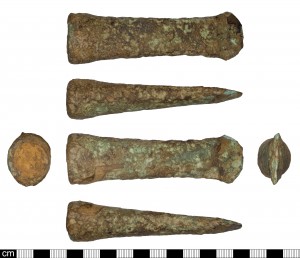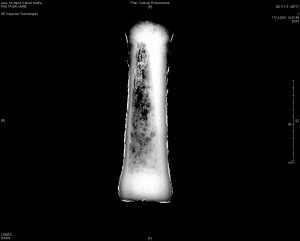One of the sometimes frustrating things about this job is that because of the quantity of material to be recorded and because mostly the items belong to the landowners or finders and not the museum it is usually not possibly to do any detailed investigation or research in to them. I am aiming to make records which can then be used by other researchers rather than doing the research . It is therefore particularly pleasing when we get to go a little bit beyond the basic record.

Late Bronze Age Taunton-Hademarschen type axe
This axe (SOM-62A847) was brought in to me last year and was clearly an unusual type, much longer and thinner than most socketed axes. It is a variant of the Taunton-Hademarschen type with oval rather than square mouth dating to Late Bronze Age, 1000-800 BC. The name incidentally reflects the two ends of the known distribution and they tend to be concentrated from Somerset-South Wales, along the south coast and over to the continent. What struck me was the iron pan over the mouth of the socket. Iron pan usually builds up in waterlogged conditions and although the findspot it is now a dry ploughed field it was obviously wet in the past. Bronze Age metalwork is deposited into water so I speculated it may have been deposited into water originally and therefore the iron pan build up may have happen soon after deposition and could potentially preserve the haft. We don’t have funding to X-ray interesting finds but my PAS colleague at the National Museum and Galleries Wales who is interested in Bronze Age material kindly stepped in and agreed to ask his conservation department to do it with some of his material. The result was very good.

As you can see there is a large chunk of the haft surviving, the x-ray clearly picks out the grain of the wood. They also checked the composition using non destructive XRF which showed it is the typical leaded bronze for this period with perhaps slightly less lead than is common. We have left the haft in situ for the moment as removing it may be a tricky job requiring a professional conservator and it maybe the shape is only preserved in the iron pan itself. The X-ray has confirmed its existence but also provides strong evidence the axe was originally deposited in a watery context.